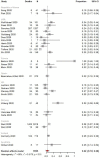Epidemiology and clinical features of COVID-19 outbreaks in aged care facilities: A systematic review and meta-analysis
- PMID: 33681730
- PMCID: PMC7917447
- DOI: 10.1016/j.eclinm.2021.100771
Epidemiology and clinical features of COVID-19 outbreaks in aged care facilities: A systematic review and meta-analysis
Abstract
Background: COVID-19 outbreaks in aged care facilities (ACFs) often have devastating consequences. However, epidemiologically these outbreaks are not well defined. We aimed to define such outbreaks in ACFs by systematically reviewing literature published during the current COVID-19 pandemic.
Methods: We searched 11 bibliographic databases for literature published on COVID-19 in ACFs between December 2019 and September 2020. Original studies reporting extractable epidemiological data as part of outbreak investigations or non-outbreak surveillance of ACFs were included in this systematic review and meta-analysis. PROSPERO registration: CRD42020211424.
Findings: We identified 5,148 publications and selected 49 studies from four continents reporting data on 214,380 residents in 8,502 ACFs with 25,567 confirmed cases of COVID-19. Aged care residents form a distinct vulnerable population with single-facility attack rates of 45% [95% CI 32-58%] and case fatality rates of 23% [95% CI 18-28%]. Of the cases, 31% [95% CI 28-34%] were asymptomatic. The rate of hospitalization amongst residents was 37% [95% CI 35-39%]. Data from 21 outbreaks identified a resident as the index case in 58% of outbreaks and a staff member in 42%. Findings from the included studies were heterogeneous and of low to moderate quality in risk of bias assessment.
Interpretation: The clinical presentation of COVID-19 varies widely in ACFs residents, from asymptomatic to highly serious cases. Preventing the introduction of COVID-19 into ACFs is key, and both residents and staff are a priority group for COVID-19 vaccination. Rapid diagnosis, identification of primary and secondary cases and close contacts plus their isolation and quarantine are of paramount importance.
Funding: Queensland Advancing Clinical Research Fellowship awarded to Prof. Gulam Khandaker by Queensland Health's Health Innovation, Investment and Research Office (HIRO), Office of the Director-General.
Keywords: Aged care facility; Clinical features; Coronavirus disease 2019; Covid-19; Epidemiology; Nursing homes; Outbreak; SARS-CoV-2.
© 2021 The Authors.
Conflict of interest statement
Professor Robert Booy has received funding from Baxter, CSL, GSK, Merck, Novartis, Pfizer, Roche, Romark and Sanofi Pasteur for conducting research other than this, and for travel to conferences or consultancy work. All other authors declare no competing interests.
Figures






References
-
- World Health Organization. WHO Director-General's opening remarks at the media briefing on COVID-19–11 March 2020 https://www.who.int/dg/speeches/detail/who-director-general-s-opening-re... (Accessed on October 25, 2020).
-
- United Nations . May 2020. Policy brief: the impact of COVID-19 on older persons; p. 3.https://unsdg.un.org/sites/default/files/2020-05/Policy-Brief-The-Impact... viewed 11 September 2020. (Accessed October 25, 2020)
-
- Johns Hopkins University. Coronavirus resource center 2020 [cited 2020 October 22, 2020]. https://coronavirus.jhu.edu/. (Accessed on January 29, 2021).
LinkOut - more resources
Full Text Sources
Other Literature Sources
Miscellaneous

